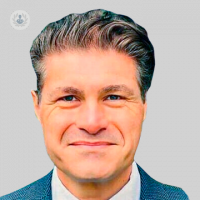How are hemifacial spasms treated?
Written by:In this article below, distinguished consultant neurosurgeon, Professor Ludvic Zrinco, details what hemifacial spasms are, and how they are typically treated, in both mild and severe cases.

What are hemifacial spasms?
Hemifacial spasms are involuntary muscle contractions that affect one side of the face, causing twitching or spasms in the facial muscles. These spasms typically occur on one side of the face, but in rare cases, they can affect both sides. While hemifacial spasms are not usually painful, they can be bothersome and can interfere with daily activities, including speaking, eating, and social interactions.
What causes hemifacial spasms?
The exact cause of hemifacial spasms is not always clear, but they are often attributed to compression or irritation of the facial nerve, which controls the muscles of the face. This compression or irritation can result from a variety of factors, including blood vessel abnormalities, tumours, nerve damage, or injury to the facial nerve. In some cases, hemifacial spasms may be associated with conditions such as multiple sclerosis or Bell's palsy.
What are the main associated symptoms?
Symptoms of hemifacial spasms typically begin gradually and may worsen over time. The spasms may start as mild twitches or tics in the muscles around the eye, nose, or mouth and can progress to more severe and frequent spasms that affect larger areas of the face. In some cases, hemifacial spasms may be triggered by certain activities or stimuli, such as stress, fatigue, or caffeine consumption.
How are hemifacial spasms treated?
Treatment for hemifacial spasms aims to reduce the frequency and severity of muscle spasms and improve quality of life. Medications such as muscle relaxants or anticonvulsants may be prescribed to help control spasms and reduce muscle contractions. In cases where medication is not effective or well-tolerated, botulinum toxin injections (Botox) may be recommended to temporarily paralyse the affected facial muscles and reduce spasms.
In more severe cases of hemifacial spasms, surgical interventions may be considered to relieve pressure on the facial nerve and alleviate symptoms. Microvascular decompression surgery is a common surgical procedure used to relieve compression of the facial nerve by repositioning or removing the blood vessels or tissues causing the compression.
To book an appointment with Professor Ludvic Zrinco today, just visit his Top Doctors profile.


